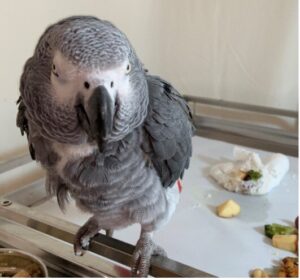
Last month, I wrote about how we were having issues with getting Griffin to work on a complicated 4-cup task because he didn’t like testing when Athena was at his back and how simply rotating the apparats 90° took care of the problem. Well, we then had another problem—Griffin was now eager to work, but the issue was that he had figured out how to maximize his nut intake; thereby, making it difficult to complete the study as planned! ‘Tis an interesting story.
I didn’t explain the actual task last time, but it is critical to do that now so that it is clear how cleverly Griffin manipulated and outwitted us. I still won’t go into all the “gory” details but will highlight the important bits. So, let’s follow the logic of the figure to describe the procedure:

Which Cup Has The Nut?
You show Griffin 4 cups, A, B, C, D (a) and that all are empty. You cover A and B, and hide a nut in one of them (b). You next cover C and D, and hide a nut in one of them (c). You then show Griffin that A is empty (d). (Note that you change which cup is shown “empty” on each trial, so that Griffin can’t detect a pattern…this is just an example.) So, if Griffin understands the logic, he should deduce that, given that one nut was in the A-B side and that A is empty, his best bet is to chose B because there has to be a nut there; he could chose C or D, but because he doesn’t know which cup has the nut, he would have only a 50% chance of success. After he chooses B (which he did almost all the time), he is given a second choice.
Now, knowing that A was shown to be empty, and that he emptied B, if he wants another nut, he has to gamble; that is, deduce the logical if not optimal choice. If he guesses right, he gets another big nut. If he guesses wrong, he should get nothing. But, we knew from a previous experiment (Pepperberg et al., 2019) that he would be frustrated and might refuse to make a second choice if he failed to get any reward…thus, we gave him a tiny sliver of nut if he chose an empty cup, so that he would be encouraged to continue the study.
After we had done the rotation of the apparatus, Griffin decided to be a bit innovative. He had previously completed an interesting study (Pepperberg & Hartsfield, 2014) where he had learned about how choice of one option leads to two rewards and choice of the other leads to one; the concept involved balancing certainty and uncertainty. He seemed to apply that logic here…now, after seeing that A was empty, and knowing that B was certain, he began the trial by gambling. He knew B had a nut; if he gambled, he figured he’d get either a big or small nut and then could get the certain nut on the second try. But he did something even more clever.
Griffin’s Gamble
The first two times, he won the gamble, so he got a big nut and then on his second choice got the certain nut; he ended up with two big nuts. No problem with our protocol, though we noted that he was not quite doing what we expected. The third time, however, he chose an empty cup when he gambled, and I gave him the tiny reward. On his second choice, he correctly figured that the cup next to that one would be full, and got a big reward. Hmm… he showed he understood the logic, but that wasn’t what we had intended—he was supposed to switch sides. And, before we could react, he then did switch sides, and grabbed the certain reward!
Thus, he managed to get more than the two big nut rewards…he got two plus the tiny bit! Although we felt that he was still demonstrating an understanding of the logic, we feared that colleagues criticizing the study could argue that he was just working his way down the line of cups, seeing what he could get without really thinking…Clearly, that was not what we wanted! Thus, we decided to discourage gambling—the next time he gambled at the beginning of the trial, we pulled the tray away to show him that the behavior was not acceptable…and he got nothing. The expression on his face was priceless! It was clear that he was shocked. In his mind, he had not done anything wrong! He had simply figured out how to game the system…and was obviously upset that he was being punished. He then refused to do any trials, on any study, the rest of that day. Point taken!! (To be blunt…who was the smart one?)
Our plan now is to give him two choices total, and then pull the tray. If he gambles, wins, and switches sides, we will let him get his nuts, but will call it a mistrial and redo the trial to maintain our protocol. If he gambles, loses, and gets a small nut, we’ll let him do a second trial to get a large nut…but, again, we’ll call it a mistrial and redo the trial. We hope that that way he will realize that he can never get 2+ nuts, but not be so discouraged that he won’t do any more work that day. FINGER X’D!
References
Pepperberg, I.M., & Hartsfield, LA. (2014) Do Grey parrots (Psittacus erithacus) succeed on a “complex” foraging task failed by primates but solved by fish? J. Comp. Psychol. 128:298-306.
Pepperberg, I.M., Gray, S.L., Cornero, F.M., Mody, S., & Carey, S. (2019). Logical reasoning by a Grey parrot (Psittacus erithacus)? A case study of the disjunctive syllogism. Behaviour 156:409-445.
